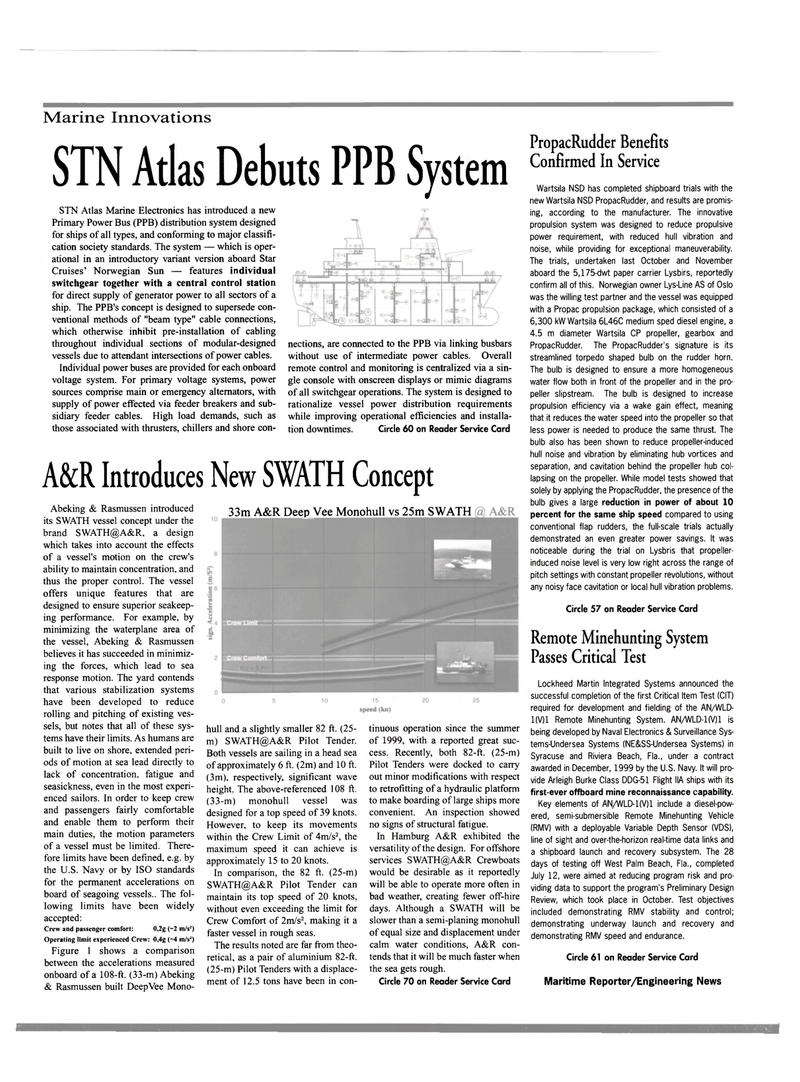
Page 43: of Maritime Reporter Magazine (December 2000)
Read this page in Pdf, Flash or Html5 edition of December 2000 Maritime Reporter Magazine
Marine Innovations
STN Atlas Debuts PPB System
STN Atlas Marine Electronics has introduced a new
Primary Power Bus (PPB) distribution system designed for ships of all types, and conforming to major classifi- cation society standards. The system — which is oper- ational in an introductory variant version aboard Star
Cruises' Norwegian Sun — features individual switchgear together with a central control station for direct supply of generator power to all sectors of a ship. The PPB's concept is designed to supersede con- ventional methods of "beam type" cable connections, which otherwise inhibit pre-installation of cabling throughout individual sections of modular-designed vessels due to attendant intersections of power cables.
Individual power buses are provided for each onboard voltage system. For primary voltage systems, power sources comprise main or emergency alternators, with supply of power effected via feeder breakers and sub- sidiary feeder cables. High load demands, such as those associated with thrusters, chillers and shore con- nections, are connected to the PPB via linking busbars without use of intermediate power cables. Overall remote control and monitoring is centralized via a sin- gle console with onscreen displays or mimic diagrams of all switchgear operations. The system is designed to rationalize vessel power distribution requirements while improving operational efficiencies and installa- tion downtimes. Circle 60 on Reader Service Card
A&R Introduces New SWATH Concept
Abeking & Rasmussen introduced its SWATH vessel concept under the brand SWATH@A&R, a design which takes into account the effects of a vessel's motion on the crew's ability to maintain concentration, and thus the proper control. The vessel offers unique features that are designed to ensure superior seakeep- ing performance. For example, by minimizing the waterplane area of the vessel, Abeking & Rasmussen believes it has succeeded in minimiz- ing the forces, which lead to sea response motion. The yard contends that various stabilization systems have been developed to reduce rolling and pitching of existing ves- sels, but notes that all of these sys- tems have their limits. As humans are built to live on shore, extended peri- ods of motion at sea lead directly to lack of concentration, fatigue and seasickness, even in the most experi- enced sailors. In order to keep crew and passengers fairly comfortable and enable them to perform their main duties, the motion parameters of a vessel must be limited. There- fore limits have been defined, e.g. by the U.S. Navy or by ISO standards for the permanent accelerations on board of seagoing vessels.. The fol- lowing limits have been widely accepted:
Crew and passenger comfort: 0,2g (-2 m/s1)
Operating limit experienced Crew: 0,4g (-4 m/s2)
Figure 1 shows a comparison between the accelerations measured onboard of a 108-ft. (33-m) Abeking & Rasmussen built DeepVee Mono- 33m A&R Deep Vee Monohull vs 25m SWATH hull and a slightly smaller 82 ft. (25- m) SWATH@A&R Pilot Tender.
Both vessels are sailing in a head sea of approximately 6 ft. (2m) and 10 ft. (3m), respectively, significant wave height. The above-referenced 108 ft. (33-m) monohull vessel was designed for a top speed of 39 knots.
However, to keep its movements within the Crew Limit of 4m/s2, the maximum speed it can achieve is approximately 15 to 20 knots.
In comparison, the 82 ft. (25-m)
SWATH@A&R Pilot Tender can maintain its top speed of 20 knots, without even exceeding the limit for
Crew Comfort of 2m/s2, making it a faster vessel in rough seas.
The results noted are far from theo- retical, as a pair of aluminium 82-ft. (25-m) Pilot Tenders with a displace- ment of 12.5 tons have been in con- tinuous operation since the summer of 1999, with a reported great suc- cess. Recently, both 82-ft. (25-m)
Pilot Tenders were docked to carry out minor modifications with respect to retrofitting of a hydraulic platform to make boarding of large ships more convenient. An inspection showed no signs of structural fatigue.
In Hamburg A&R exhibited the versatility of the design. For offshore services SWATH@A&R Crewboats would be desirable as it reportedly will be able to operate more often in bad weather, creating fewer off-hire days. Although a SWATH will be slower than a semi-planing monohull of equal size and displacement under calm water conditions, A&R con- tends that it will be much faster when the sea gets rough.
Circle 70 on Reader Service Card
PropacRudder Benefits
Confirmed In Service
Wartsila NSD has completed shipboard trials with the new Wartsila NSD PropacRudder, and results are promis- ing, according to the manufacturer. The innovative propulsion system was designed to reduce propulsive power requirement, with reduced hull vibration and noise, while providing for exceptional maneuverability.
The trials, undertaken last October and November aboard the 5,175-dwt paper carrier Lysbirs, reportedly confirm all of this. Norwegian owner Lys-Line AS of Oslo was the willing test partner and the vessel was equipped with a Propac propulsion package, which consisted of a 6,300 kW Wartsila 6L46C medium sped diesel engine, a 4.5 m diameter Wartsila CP propeller, gearbox and
PropacRudder. The PropacRudder's signature is its streamlined torpedo shaped bulb on the rudder horn.
The bulb is designed to ensure a more homogeneous water flow both in front of the propeller and in the pro- peller slipstream. The bulb is designed to increase propulsion efficiency via a wake gain effect, meaning that it reduces the water speed into the propeller so that less power is needed to produce the same thrust. The bulb also has been shown to reduce propeller-induced hull noise and vibration by eliminating hub vortices and separation, and cavitation behind the propeller hub col- lapsing on the propeller. While model tests showed that solely by applying the PropacRudder, the presence of the bulb gives a large reduction in power of about 10 percent for the same ship speed compared to using conventional flap rudders, the full-scale trials actually demonstrated an even greater power savings. It was noticeable during the trial on Lysbris that propeller- induced noise level is very low right across the range of pitch settings with constant propeller revolutions, without any noisy face cavitation or local hull vibration problems.
Circle 57 on Reader Service Card
Remote Minehunting System
Passes Critical Test
Lockheed Martin Integrated Systems announced the successful completion of the first Critical Item Test (CIT) required for development and fielding of the AN/WLD- 1(V)1 Remote Minehunting System. AN/WLD-1(V)1 is being developed by Naval Electronics & Surveillance Sys- tems-Undersea Systems (NE&SS-Undersea Systems) in
Syracuse and Riviera Beach, Fla., under a contract awarded in December, 1999 by the U.S. Navy. It will pro- vide Arleigh Burke Class DDG-51 Flight IIA ships with its first-ever offboard mine reconnaissance capability.
Key elements of AN/WLD-1(V)1 include a diesel-pow- ered, semi-submersible Remote Minehunting Vehicle (RMV) with a deployable Variable Depth Sensor (VDS), line of sight and over-the-horizon real-time data links and a shipboard launch and recovery subsystem. The 28 days of testing off West Palm Beach, Fla., completed
July 12, were aimed at reducing program risk and pro- viding data to support the program's Preliminary Design
Review, which took place in October. Test objectives included demonstrating RMV stability and control; demonstrating underway launch and recovery and demonstrating RMV speed and endurance.
Circle 61 on Reader Service Card
Maritime Reporter/Engineering News

 42
42

 44
44
